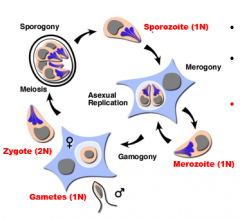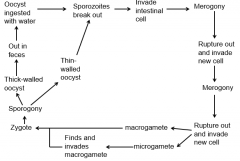![]()
![]()
![]()
Use LEFT and RIGHT arrow keys to navigate between flashcards;
Use UP and DOWN arrow keys to flip the card;
H to show hint;
A reads text to speech;
23 Cards in this Set
- Front
- Back
|
Apicomplexa apperance |
§No flagella or cilia except for themicrogamete (“sperm”) § Allmembers of the phylum are intracellular parasites §Complex life cycle: asexualand sexual forms; the development of these stages are hosttissue specific. § Apical complex: Set of organelles specialized topenetrate host cells |
|
|
Apicomplexa Penetrationof host cells: |
(1)Apicalprominence binds to host cell membrane (tight junction) (2)Rhoptries and micronemes secrete contents, resulting ininvagination of cell surface (3)Tightjunction moves along parasite surface, pulling the parasite into the host celland forming a parasitophorous vacuole. |
|
|
Apicomplexa motility |
•Apicomplexansglide through the substrate like slugs, leaving a trail of surface proteins andlipids• •Surfaceproteins bind to the substrate and move along the cell surface, propelling theparasite forward.• •Aprotease (“sheddase”)cleaves the proteins at the end of the cell to detach from the substrate |
|
|
Generalapicomplexan life cycle= |

|
|
|
General apicomplexan life cycle 2 |
•Replicationonly occurs within host cells
•Withinthe host cell the parasite develops in the parasitophorousvacuole •Zygote (“ookinete”)formation from fusion of micro- and macrogametes |
|
|
General apicomplexan life cycle 3
|
•Sporogony– schizogony of zygote toproduce sporozoites;single meiotic division followed by mitotic divisions –oocyst–encysted zygote –sporocyst– acyst within an oocyst containing sporozoites(1,2,4,8,16) •Merogony–multiple fission in a host cell to produce merozoites–multiplegenerations possible –schizont –cell containing multiple merozoites•Gametogony–differentiation of merozoite intomicro- or macrogametes –Twophases: •growthphase–multiple fission of nucleus•differentiationphase–multiple fission of cytoplasm to form gametes |
|
|
Cryptosporidium parvum |
•Transmissionby oocysts incontaminated water or food; too small to be filtered out by normal watertreatment facilities. •Invadesand lyses intestinal epithelium cells.•Symptoms–severe watery diarrhea, abdominal cramping, and weight loss. –Normally1-10 day infection –Severe infection in AIDS patients •6-25bowel movements per day•Dehydration,electrolyte imbalance, and death. |
|
|
Cryptosporidium parvum 2
|
•Diagnosis: Oocysts in fecal float.•Treatment: None. Testing nitazoxanide. Lack mitochondria so drugs that killanaerobic bacteria may be effective.•Prevention: Filtered or bottled water.–Municipalwater systems can’t filter out the oocysts and chlorine does not kill oocysts.•Boilingand freezing below -10oF does kill it.–Outbreakshave occurred in many areas•Particularlyin the spring•This is another organism that has onlybecome known due to AIDS research. |
|
|
CryptosporidiumLife Cycle |
•Ingestion of oocyst,sporozoites emerge•Sporozoites invade intestinal cells •Merogony for multiple generations in intestine•Gametogony in intestine •Oocysts released in feces |
|
|
Cryptosporidium Life Cycle 2 |

|
|
|
Toxoplasma gondii |
•“Toxoplasma”derives from the Greek (toxon: bow) in reference to the organism’screscent shape •Broadhost and tissue specificity; infects almost all nucleated cells. •Mostpeople show no or benign symptoms (headache, sore throat, fever) |
|
|
Toxoplasma gondii 2 |
•DefinitiveHost: Cats of many species•IntermediateHosts:domestic and wild animals – Anything a cat would eat –Humans– accidental host and dead end•GeographicDistribution: Cosmopolitan–50%prevalence in U.S.–13%worldwide •Modeof Transmission: Cat ingests infected host or oocyst –Humansaccidentally ingest oocysts in feces |
|
|
Life cycle of Toxoplasma gondii |
•Intestinalphase (cats): •Cat ingests oocysts or tissue cysts, which release sporozoites •Merogony for multiple generations•Gametogony produces oocysts which are excreted in the feces andremain infective for months. • •Oocysts must sporulate to become infective (about 48hours after defecation) |
|
|
Life cycle of Toxoplasma gondii2 |
•Tissuephases (intermediate host): • IH ingests oocysts or tissue cysts, which release sporozoites • Sporozoitespenetrate the intestine and invade macrophages and other types of cells. • Parasites multiply by merogony Merogonyin IH: • “Tachyzoites” arereleased which will invade new host cells • As the host develops immunity,replication rate slows down and parasites form “tissue cysts” containing “bradyzoites”. |
|
|
Toxoplasma gondii parasiticforms |
•TACHYZOITES:rapidly growing meronts observed in the early stage of infection • BRADYZOITES:Slow-growing merontsinside the tissue cysts • TISSUE CYSTS:Found in the tissues and contain bradyzoites. Infective form. OOCYSTS:Zygote form. Highly resistant. Infective form |
|
|
Bradyzoite cysts |
•Bradyzoites markthe beginning of the chronic phase of infection •Tissuecysts show very little evidence of inflammation or immune cell infiltrates.•Bradyzoites (not tachyzoites) are resistant to low pH and digestiveenzymes during stomach passage •Protective cyst wall is eventuallydissolved and bradyzoites infect tissue to transform into tachyzoites •Tachyzoites:pathogenesis Bradyzoites:transmission |
|
|
Toxoplasma crieteria |
•Threesituations can lead to severe disease: 1) ocular toxoplasmosis 2) lossof a functional immune system 3) congenital toxoplasmosis |
|
|
Effects of Toxoplasmosison Intermediate Hosts |
•Abortionand stillbirth in many mammals•Neurologicalsymptoms– head shaking, lack of co-ordination, seizures and tremors •Rats–behaviors that increase transmission –decreased ability to learn in mazes –increased activity –increased preference for exposed areas–Attracted to cat urineR |
|
|
Toxoplasmosis Prevention |
•Avoidraw or undercooked meat. (Cooking kills Toxoplasma) •Wash raw fruits and vegetables wellbefore eating. •Remove cat feces from the litter box every day, to eliminate any parasitesbefore oocysts sporulate •Keep cats from getting infected: • Prevent hunting (keep indoors) • Feed cats only commercial food or well-cooked meat. • Do not adopt cats who have lived outdoors orwho have been fed raw meat. • Do not handle stray cats.• •Wash hands well with soap and warm water after: • Gardening • Yard Work• • There is no treatment available to prevent Toxoplasma in cats, or to prevent an infected cat from shedding the parasite in its stool.{i |
|
|
TreatingToxoplasmosis] |
•Combination of: -Pyrimethamine– antimalarial drug -Sulfonamides– class of antibiotics that workssynergistically with pyrimethamine - side effects can be severe inAIDS patientst |
|
|
T. gondii andHuman Behavior" |
•Acuteinfections can cause schizophrenic symptoms Reactivationof cysts in AIDS patients cause delusions, auditory hallucinations and “thoughtdisorders” •Sexdifferences: –Infectedmen more likely to score lower on relationship warmth, self-control andtidiness (increased “masculine” traits) –Femalesopposite response. –Bothmore guilt-prone |
|
|
Babesia |
•Blood-borne parasite transmitted by Boophilussp.ticks •Infects cattle,deer, water buffalo, zebu •Found in Texas (previously), South Americaand Africa •Transovariantransmission inticks |
|
|
Babesia Pathology: |
•Infects only red blood cells and cancause severe anemia. •Occasional infections of humans usuallygo undiagnosed •Symptoms: Babesiosis or Texas red-water fever –Hemoglobin excreted by kidneys results inred urine –Cattle become listless and lose appetite –Once infection clears, cow is immune –More severe in adults than calves •50-90% mortality in untreated adultcattle.ong |

